You are feeling excited after booking the trip of a lifetime. That’s when the realisation sets in. You are going to be climbing Mount Kilimanjaro, the highest mountain in Africa.
It’s a hike that will take you up to 5,985 m/ 19,636 ft above sea level. Seriously, what were you thinking haha!
What do you wear for the hike? Will you be able to do climb to the summit? How fit do you need to be? How cold will it be at the top? How will the high altitude affect you?
These are some of the thoughts and questions that went through my mind after I had booked my bucket list trip to climb Mount Kilimanjaro in Tanzania.
- I booked my trip with G Adventures, I’ve used them for many other trips and highly recommend them. You can check out tour costs and availability here
Here’s a useful guide for anyone that is preparing to take on this awesome challenge.
Whether you are a seasoned hiker or this is your first big adventure be sure to read here for useful hints and tips to help you prepare for your trip.
From what to pack, what training you need to do to prepare for the climb plus first-hand tips from someone who reached the summit (and found it tough!)
Also included is my Mount Kilimanjaro packing list so you can be sure not to leave anything important behind on your trip to Tanzania!
Preparing to Climb Kilimanjaro
- Fitness & Training – How fit do you need to be?
- Entry requirements – Preparations for the trip
- Health & vaccinations – What you need before going to Tanzania
- Equipment – including hiking boots and day rucksack
- Packing list – clothes and other equipment
- Other FAQ – top tips, altitude sickness, money etc
Climbing Kilimanjaro – Are you Fit Enough for the Hike?

How do you train for Kilimanjaro? Well, you can always be fitter so let’s start there. Don’t all of a sudden go crazy and push yourself too much, that’s no fun!
The best type of activity you can do to train is aerobic. Anything that gets your heart pumping faster will be great. So walking, hiking, jogging or cycling. Most of these you can fit in with your busy lives.
The hiking time you’re walking each day is on average between 4-6 hours (except the summit night). Then you have breaks and lunch stops on top of that.
The key is to take your time, enjoy the scenery and walk slowly. Build your training up and practice hiking on multi-days to get your legs used to hiking without a day’s rest.
Although a challenging hike, to climb Kilimanjaro it doesn’t require any technical skills or ability. Just a good level of fitness and the right equipment. Start that training programme sooner rather than later. It will make the experience much more enjoyable.
How do you train for the summit night? Remember that although fitness is a factor, the mental challenge of hiking slowly up the mountain is tougher than any physical challenge.
Be prepared for that night to be tough and if it’s easier that’s a bonus!
Click here to read: Why I chose the Rongai route to hike Kilimanjaro
Becky’s Tips for Climbing Kilimanjaro
- Try to increase your activity during the week.
- Go for a walk on your lunch hour or jump off the bus 1 or 2 stops earlier so you can increase your miles.
- At the weekend (or days off) fit in a longer walk, cycle or run.
- Go for a hike with your rucksack to practice walking with extra weight.
What are the Entry Requirements for Tanzania?
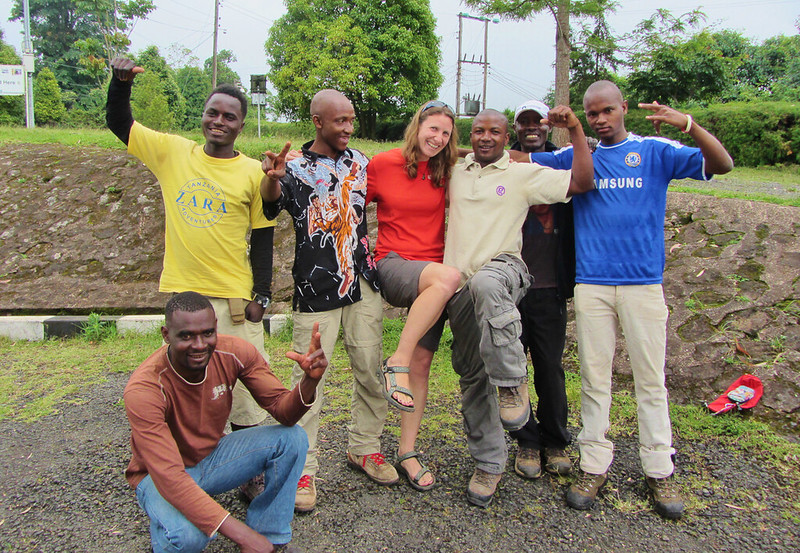
This, of course, depends on your passport! But an important job to tick off the list before you go. Check out my links to my Travel Resources where I do my research before I travel.
Please note this is for UK travellers. If non-UK then please check your own government requirements.
My recommendation would be to get your visa from the Tanzanian High Commission before you travel. It saves worrying about when you arrive.
Becky’s Tips for preparing to Climb Kilimanjaro
- When does your passport expire? You normally need at least 6 months.
- Research entry requirement early on in your preparations
Do I need any injections before I go?
Ok so not one of the most exciting things to do but definitely essential. Vaccinations can easily be forgotten about especially with so many more exciting things to plan. Check online what is recommended. You can check out the UK ‘Fit For Travel‘ which is a very comprehensive site.
Becky’s Tips for Climbing Kilimanjaro
- Check these out in plenty of time (6-8 weeks beforehand), it’s one of those jobs you can get out of the way early on.
- Some injections need two appointments as well.
What equipment do I need for climbing Kilimanjaro?
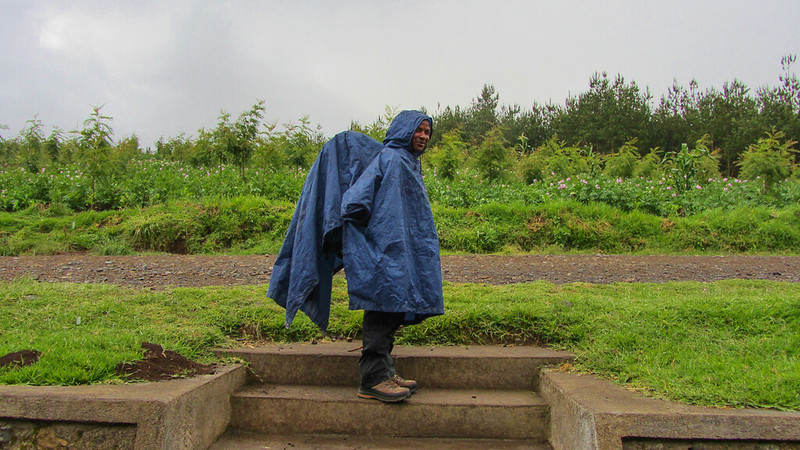
- Day rucksack
- Hiking boots
- Hiking poles
- Sleeping bag
- Camera (optional)
What Size Backpack Should you Take for Climbing Kilimanjaro?
Your daypack needs to be big enough to carry anything you might need on your day’s hike. I would recommend anything between 25-35 litres.
The porters are super speedy hiking up Kilimanjaro so anything they are carrying will disappear into the distance and you will only see when you reach camp.
It’s also useful to have pockets either side of your rucksack for your water bottle so you can easily access on the hike.
A waterproof cover or dry bags are also a great idea (just in case it rains).
Becky’s Tips for Hiking Kilimanjaro
- Do a test pack before you go to Mt Kilimanjaro. Does everything fit into your rucksack, including space for water?
Have you got the Right Hiking Boots?
Walking boots can make or break for whether you are going to enjoy hiking Kilimanjaro. Pick the wrong pair and you could be in for some sad hiking miles!
Treat your feet with respect, don’t just buy a cheap pair or borrow some from a friend. I wore my ‘Scarpas’ and I loved them but pick what is right for you.
Top tip
When you’re training for your Mt Kilimanjaro trip, make sure you test your gear and hiking boots out too.
Becky’s Tips for Climbing Kilimanjaro
- Wear your boots beforehand to ensure they are worn in properly.
- When buying your boots, take some hiking socks with you.
- Most stores will lend you there’s but who knows how many people have worn them!
Check out the Best hiking trails in the world
Should you take Hiking Poles?
I have done hikes with and without hiking poles. My preference now is not to use them but that’s because I love taking so many photos and the poles get in the way!
But on a serious note walking poles really do help you, on both the up and downhills.
You can read about my recent adventure in Wales, the Welsh 3000s Challenge, where my hiking poles were amazing (a challenge I found harder than Kilimanjaro summit night)!
Becky’s Tips for Climbing Kilimanjaro
- If you don’t want to take your own trekking poles then you can normally hire them (check before you go).
- Remember to increase the height of the poles after summiting Kilimanjaro.
What Sleeping Bag Should You Take?
I am a huge fan of down sleeping bags, it’s actually one of the best things I have ever bought! A 3 to 4 season one is best (zero to -20 degrees).
Before you start thinking about spending extra money, check with your tour group, this might be something you can hire.
Becky’s Tips for Climbing Kilimanjaro
- If you are hiring a sleeping bag for your Kilimanjaro trip, pack a sleeping bag liner. My silk one takes up no space in my bag and adds an extra layer too.
- For campers, a Thermarest mattress is perfect to give you more comfort and keep you a bit warmer, as you are further away from the ground.
Capturing the Moment on the HIke
Our phones are amazing and there are pretty good ones out there that take awesome photos. But something you might want to consider is taking a camera as well. Cold temperatures on the mountain can cause your battery to drain much quicker.
The other thing to think about is in cold weather you will probably be wearing gloves. And you all know it’s pretty much impossible to take a photo on your camera with them on.
Climbing to Kilimanjaro summit, in freezing temperatures the last thing you want to do is take your gloves off.
Becky’s Tips for Climbing Kilimanjaro
- Keep your phone and camera batteries near your body to keep them warm. I put mine in some socks and kept them in my sleeping bag
Climbing Kilimanjaro – The Ultimate Kilimanjaro Packing List
What clothes do you need to take?
This is a tough one, you’re going to east Africa, it is going to be hot. Yet you are hiking a mountain and I can promise you it is cold at the top! How do you pack the right gear without taking your entire wardrobe?
Some tour groups will carry a certain weight of your belongings. I booked my Kilimanjaro climb via GAdventures, a responsible travel company. The bag allowance was 15 kg.
I’d recommend a duffel bag for your gear on the trek, I used one on my winter Atlas Mountains hike in Morocco and it’s perfect for adventure trips. You can read my review of the Eagle Creek duffel bag here.
Here’s my Kilimanjaro kit list:
- Walking boots
- Shoes/sandals (for the campsite). I love my Teva sandals perfect for the rocky ground at camp
- Waterproof jacket & trousers
- Warm jacket and trousers (Down jacket is perfect)
- Walking trousers (perfect with zip-offs) x 1/2
- T-shirts (NOT cotton) x 2/3
- Long-sleeved top x 1/2
- Base layers (tops and bottoms) x 1
- Fleece x 1
- Hiking socks x 4
- Underwear + bra (sports bras are ideal – if you’re a lady!)
- Warm hat and a sun hat (or bandana)
- Gloves (thin and thick pair) I also took a fingerless pair – handy at the campsite
- Balaclava or buff (I used my sarong as a scarf)
- Clothes for camp (same outfit for every night!!)
Becky’s Tips for Climbing Kilimanjaro
- Lots of thin layers are much better than one or two thick ones. They help trap the heat and keep you warmer.
- Save space and wear the same hiking outfit every day (plus or minus a few layers).
- Do not bring cotton clothes, these aren’t great for dealing with moisture, ie sweating!!
What else do you need to take?
- Day rucksack (25-35 litres) + waterproof cover
- Sleeping bag (or hire one)
- Sleeping bag liner
- Mattress (optional)
- Water bottle and/or platypus water carrier (enough to carry at least 2 litres)
- Head torch (plus spare batteries)
- Water bottle and/or flask. Platypus with a drinking tube is great too
- Sun cream and sunglasses
- Watch
- Hiking poles (optional)
- Wet wipes (your daily wash)
- Toilet paper
- Playing cards (just for fun)
- Earplugs & eye mask
- Snack food and energy bars
- Camera and spare battery
- Toiletries (essentials only, there are no showers so don’t expect to wash your hair)
- Travel plug (for the hostel/hotel)
Becky’s Tips for Climbing Kilimanjaro
- My platypus drinking tube froze on the summit night so be sure to have a backup option!
- Sigg Hot and Cold flask keep drinks hot for up to 10 hours so perfect for the climb on the summit night.
What Should You Take in Your First Aid Kit?
Firstly, this is an essential piece of kit when preparing for your hike. You don’t want something ruining your trip that you could have prevented. You might think I am a hypochondriac when you read this list.
But honestly, I would rather know that I can look after myself if I feel ill. Especially on a mountain!
- Sun cream
- Plasters including blister ones
- Paracetamol/aspirin
- Ibuprofen
- Lip balm or Vaseline
- Cold and flu tablets
- Cough sweets (something about high altitude makes your throat dry)
- Imodium
- Constipation tablets
- Altitude tablets (optional – I have never used so check with your Doctor)
- Malaria tablets (again check with your Doctor – I used Malarone)
- Travel sickness pills and ginger sweets (for the drive to the starting point)
Becky’s Tips for Climbing Kilimanjaro
- After you have summited remember to put sun cream on – speaking from experience as I burnt my face on the way down :(.
Other Questions for your Climb up Kilimanjaro
How will the altitude affect you whilst climbing Kilimanjaro?
High altitude affects different people in different ways. You might experience mild ‘Acute Mountain Sickness’ (AMS) symptoms or maybe something a bit worse.
The key is to listen to your body, don’t push yourself beyond its limits. Always talk to your guide if you feel unwell. These guys really are the experts so listen to them as well.
I experienced mild headaches, to begin with, whilst climbing Kilimanjaro, but water and paracetamol sorted those out.
On arrival at base camp, I felt quite sick and had a loss of appetite. I felt sick once I started the summit hike at around 11 pm but after a couple of hours, I found a big rock to throw up behind and felt better!
Remember preventing altitude sickness is not something you can train for, it affects some people and not others.
Read here: Top tips for preventing altitude sickness
Becky’s Tips for Climbing Kilimanjaro
- Drink plenty of water and I mean 2/3 litres a day. It’s really important to keep hydrated.
- Keep eating even if you do have a loss of appetite.
How much money should you take?
Once you are on the mountain there are no cash machines, no shops, nothing that you need money for.
If you’re like me then you will probably have an awesome guide and a great team of porters supporting you on your multi-day hike on Kilimanjaro.
Don’t forget to put some money aside for their tip once you’ve completed the trek.
What if you are travelling onwards and won’t need all the warm clothes?
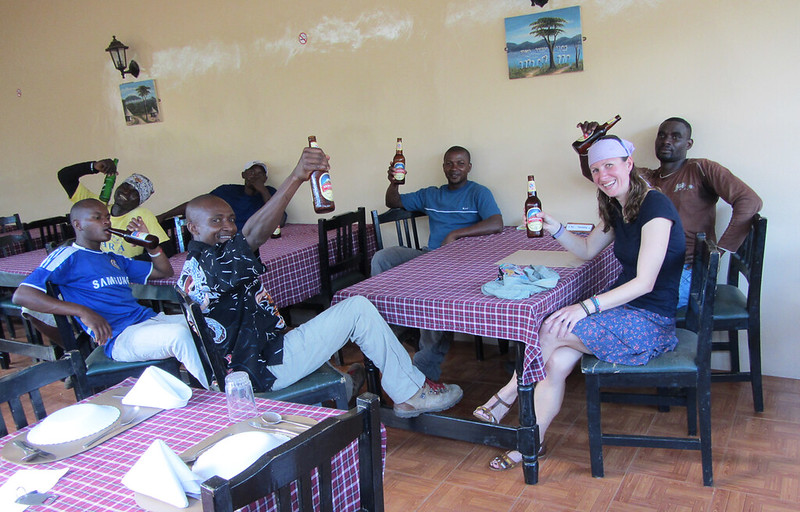
This is an easy one. You have 2 options. 1) Send everything you don’t need back home or 2) Donate any clothes or equipment you won’t use to your guide or porters.
My next destination was South East Asia so I had no need for thick mittens and a balaclava! Unless I ran out of money and wanted to try bank robbing…. only joking of course!
Love hiking? Check out some more of my hiking adventures here
Are you preparing to climb Kilimanjaro? Want to know any more tips for hiking Kilimanjaro or is there anything else that you would like to know before you go?
Ask me any questions about the hike in the comments below.
Pin to your hiking boards on Pinterest



*Becky the Traveller participates in the Amazon Services Associates Programme, as well as other affiliate programmes. If you make a purchase through these, I earn from the qualifying links. This is at no extra cost to you. Read more here.



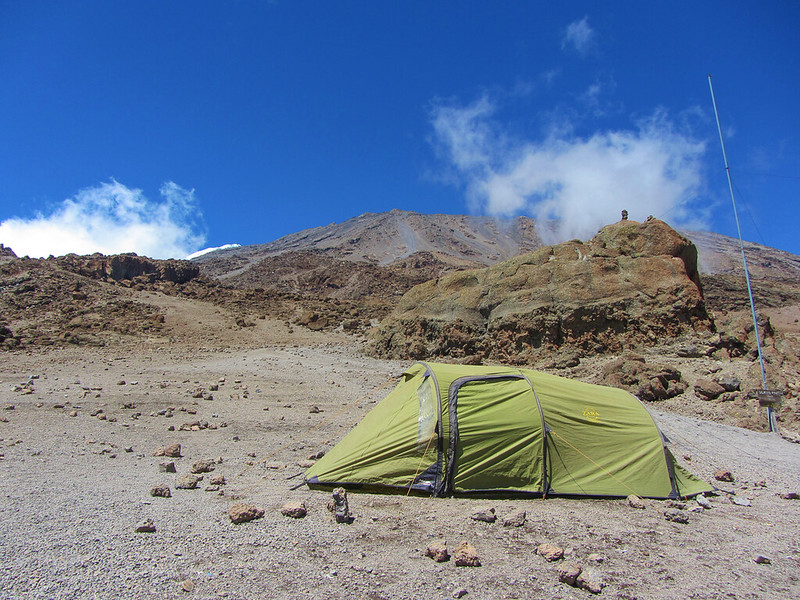
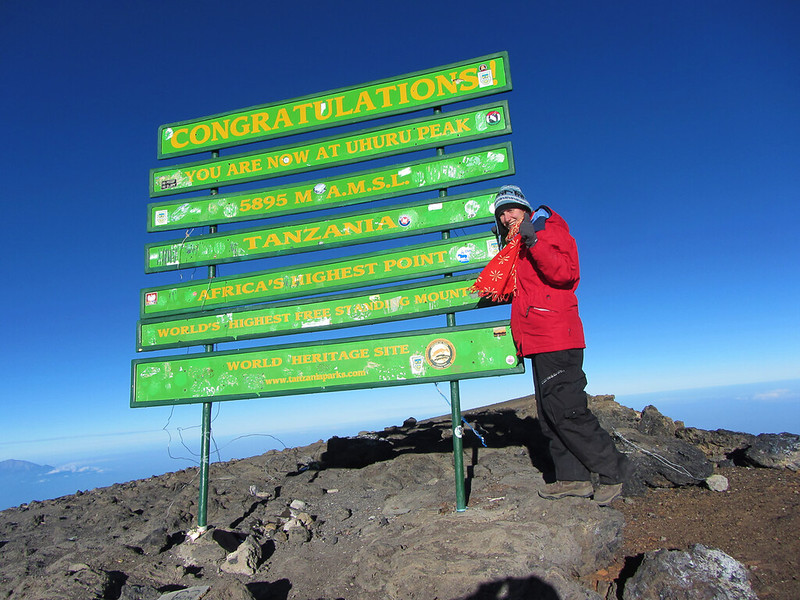

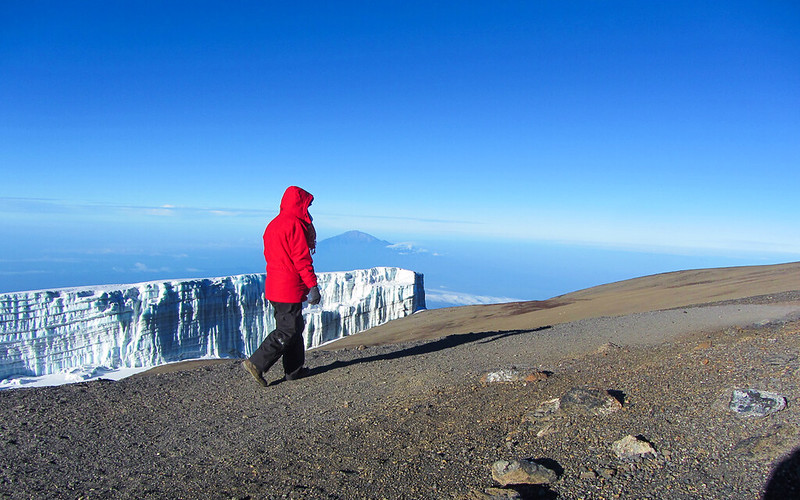
Great tips ! For sure before climbing, an essential part of your preparation will be to ensure that you are well equipped for your summit attempt. Be physically prepared is also a key point: it is important that your body is adequately prepared for the physical challenges of Mount Kilimanjaro 🙂
Ah thank you I am glad that you found them useful. Yes it certainly makes it more enjoyable if you’re a little bit fitter but it’s not the only thing!!
You are one brave cookie, I could NEVER do that. I mean, I could probably, eventually, manage the hike up there but the rest…no thanks. I am not a camper or enjoy the outdoorsy life at all. haha and I am always so curious on how others can be so free and willing to sleep without the basic necessities. I would love to visit Tanzania one day though.
Ah thanks so much Anita, that’s a lovely thing to say. I guess I’ve just always been an outdoorsy kind of person so quite happy with a simple life. Tanzania is beautiful but it is pretty simple so you might need to rough it a bit!!! 🙂
How did you keep your camera and phone charged? I’m thinking solar charger but wonder if there is a better option? Also dumb question maybe but can you get wifi on the mountain?
I only used my camera for photos and didn’t use my phone the entire trip, the campsites are basic so no wi-fi. I just bought a spare battery and tried not to waste battery by looking through the photos as that uses battery up. You can buy spare batteries for most cameras fairly cheaply and I think it gives you peace of mine. I always have a spare battery with me when I go out even for a day trips as you never know what you might want to photograph or video!
Hi Becky, I am climbing Kilimanjaro in Feb 2018 with an overnight in the crater. You mentioned that you took Teva Sandals. I LOVE my Teva sandals but thought they may be too cold for camps at night and that I would need close toed shoes if it’s wet. What do you think? I wanted something without laces.
Hi Jerry,
It’s always good to meet a fellow Teva lover!! I completely see what you mean regarding cold and wet but to be honest, the cold is really only an issue once you get higher up. And I went for the very stylish socks and sandals look. Once you’re at camp you just want something quick and easy to pop on for nipping to the toilet etc. And as a back up you can always put your hiking boots on if it’s really wet. I find my Teva’s really practical and because they have decent grips on the bottom I could wander and explore around camp and give my feet a breather! Hope that makes sense!
Let me know if you have any more questions. Becky 🙂
Argh. A group of our friends did this a few years ago and I wanted to join them sooo much! It was the year we got married and bought our flat, so we just couldn’t afford it. Boo! 🙁
Still, now I’m married we won’t have that kind of a crazy expensive year again…so maybe I can use your advice and set up an adventure!? 😉
sounds like the best plan Josy, go for it!!! 🙂